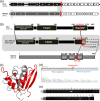Genomic profile analysis of diffuse-type gastric cancers
- PMID: 24690483
- PMCID: PMC4056347
- DOI: 10.1186/gb-2014-15-4-r55
Genomic profile analysis of diffuse-type gastric cancers
Abstract
Background: Stomach cancer is the third deadliest among all cancers worldwide. Although incidence of the intestinal-type gastric cancer has decreased, the incidence of diffuse-type is still increasing and its progression is notoriously aggressive. There is insufficient information on genome variations of diffuse-type gastric cancer because its cells are usually mixed with normal cells, and this low cellularity has made it difficult to analyze the genome.
Results: We analyze whole genomes and corresponding exomes of diffuse-type gastric cancer, using matched tumor and normal samples from 14 diffuse-type and five intestinal-type gastric cancer patients. Somatic variations found in the diffuse-type gastric cancer are compared to those of the intestinal-type and to previously reported variants. We determine the average exonic somatic mutation rate of the two types. We find associated candidate driver genes, and identify seven novel somatic mutations in CDH1, which is a well-known gastric cancer-associated gene. Three-dimensional structure analysis of the mutated E-cadherin protein suggests that these new somatic mutations could cause significant functional perturbations of critical calcium-binding sites in the EC1-2 junction. Chromosomal instability analysis shows that the MDM2 gene is amplified. After thorough structural analysis, a novel fusion gene TSC2-RNF216 is identified, which may simultaneously disrupt tumor-suppressive pathways and activate tumorigenesis.
Conclusions: We report the genomic profile of diffuse-type gastric cancers including new somatic variations, a novel fusion gene, and amplification and deletion of certain chromosomal regions that contain oncogenes and tumor suppressors.
Figures




References
-
- Ferlay J, Soerjomataram I, Ervik M, Dikshit R, Eser S, Mathers C, Rebelo M, Parkin DM, Forman D, Bray F. GLOBOCAN 2012: Estimated Cancer Incidence, Mortality and Prevalence Worldwide in 2012. http://globocan.iarc.fr. - PubMed
-
- Lauren P. The Two histological main types of gastric carcinoma: diffuse and so-called intestinal-type carcinoma. An attempt at a histo-clinical classification. Acta Pathol Microbiol Scand. 1965;64:31–49. - PubMed
Publication types
MeSH terms
Substances
LinkOut - more resources
Full Text Sources
Other Literature Sources
Medical
Research Materials
Miscellaneous

